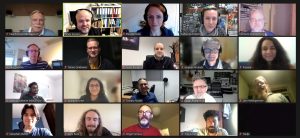
Starting from the basic theory of spatial hearing, Katharina showed the influence and development of head-related transfer functions (HRTFs), their acquisition and which parts of the listener’s anatomy influence them. Her research is very important to improve the sound reproduction through headphones to create a binaural spatial listening experience.
HRTFs contain the information of interaural time and level differences so that a listener can localise sounds in the horizontal plane; and monaural spectral features for localisation of sounds in the median plane. Katharina elaborated on the anatomical parts that influence certain frequency ranges. Besides the shoulders and head, localisation is affected by the shape of outer ears (lat. pinnae), which scatter and focus sound at the entrance of the ear channel for each individual. It is important for localising high-frequency components above 6kHz.
In the last few decades, the improvement of personal computers and computational clusters has opened up the possibility of numerically calculating HRTFs based on listener anatomy for the full hearing range. Besides a geometric data acquisition with laser scanner, computer tomography or magnetic resonance imaging, there is also the idea of using photogrammetry. These algorithms analyse pinnae images from different angles and generate a point cloud model that can be used for HRTF calculations. Katharina analyses the robustness of these photogrammetry approaches and their influence on the HRTFs. For this purpose, she showed her studies on two models in terms of accuracy, complexity and computation time and evaluated their performance compared to calculations from a CT scan.
With her research, Katharina wants to help finding the missing link between anthropometry and HRTFs. She wants to show what are the minimum requirements to calculate an HRTF, both from an acoustic and geometric point of view. What is the personalisation of HRTFs and what makes them individual? Her work is a very promising step towards making HRTF acquisition accessible to everyone.
